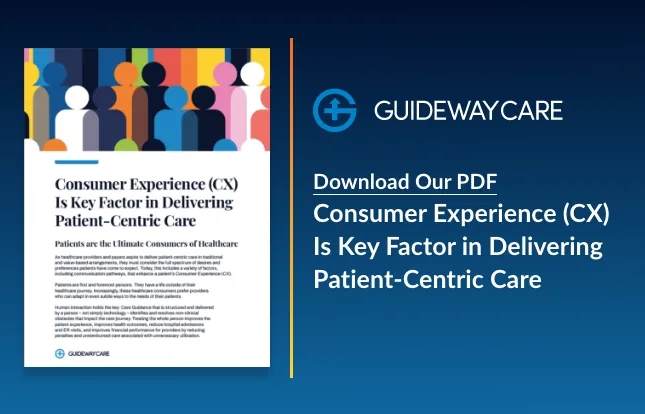Consumer Experience (CX) Is Key Factor in Delivering Patient-Centric Care – Part I

Patients are the Ultimate Consumers of Healthcare
As providers and payers aspire to deliver consumer-centric care, they must consider the full spectrum of services and activities that consumers expect and consider lifestyle issues and social barriers that impact access to quality care.
In this two-part series, readers will learn about the value of human interaction and the profound impact of personalized care guidance in resolving barriers to care attributed to SDoH, improving health outcomes and patient satisfaction, and lowering costs by reducing hospitalization and readmissions.
- Part I: Healthcare Consumerism: CX Surveys Validate Need for Human Touch
- Part II: Value of Care Guidance: Applying CX Insights to Improve Patient Experience
Part I: Healthcare Consumerism: CX Surveys Validate Need for Human Touch
Customer experience (CX) is an increasingly popular term in business, especially when it comes to long-term strategy and planning. CX refers to how a customer perceives a brand based on their exposure to it, representing the sum total of someone’s perception of, and experience with, an organization.
CX is being studied across every industry with surveys documenting the need for human interaction. These results are significantly amplified for the healthcare sector where the “human touch” is even more pronounced. The following surveys demonstrate just how important the human touch is for consumers – especially for consumers of healthcare who appreciate the support and caring guidance of a real human being.
CX Leaders: Going Beyond RPM with Human-Connected Patient Monitoring.
When it comes to the debate between tech-only and human interactions, Execs In The Know issued an insightful CX Leaders report published in March 2022. It vividly highlights the disconnect between consumers and CX officers, and a huge preference among patients for human interaction. According to this report, while 45% of corporate respondents thought consumers would prefer to use self-help to resolve their customer care issues, a self-help preference was indicated by only 15% of consumers. At the same time, only 8% of CX leaders thought “Preference for Speaking to Someone” was a factor in determining contact preferences, although this factor was selected by 47% of consumers.
It’s not hard to interpret this data, because it fits our own human experience. When we are frustrated with something that is important to us (like our health or the health of a loved one), virtually no one wants to get ‘canned’ answers that are not personalized to them, and which are not tailored and nuanced to their specific need or question in that moment.
Truist: Healthcare Executives Focused on Improving Patient Experience.
While the CX Leader report showed a disconnect between what experience officers think their consumers/patients want and what the consumers/patients actually desire, a 2022 survey by Truist Securities of hospital executives showed that executives believe they need to work on reducing readmissions and that they believe they can reduce readmissions and improve patient experience with remote patient monitoring (RPM). RPM enables monitoring of patients outside of conventional clinical settings, such as in the patient home or in a remote area, which may increase their access to care and decrease healthcare delivery costs. The survey sampled hospital CEOs and CFOs representing 677 hospitals across the U.S. on various healthcare IT and digital health topics. Among the key findings:
- 83% were looking for solutions to reduce readmissions via RPM
- 66% trying to improve patient satisfaction via RPM
- 60% attempting to improve patient health via RPM
- 17% of hospitals outsourced RPM
However, when asked “what do you see are the risks and challenges to the health system over the next 6-12 months”, these same executives pointed to areas that have a wider focus than pure clinical care:
- 57% – Labor/personnel shortages
- 27% – Transition to value-based care
- 19% – General patient satisfaction
- 11% – Consumers demanding better care delivery experience and access
- 14% of budgets allocated to population health/patient engagement over next 12 months
In these responses, it’s easy to see that healthcare executives are searching for ways to improve their connection to and with patients when the patients are “outside” the clinic walls. Unfortunately, as the consumer preferences expressed above, it’s clear that technology-only solutions (like RPM on a standalone basis) are not going to fully address the patient desire for more a more humanized experience.
Again, while RPM certainly has an important role in proactively finding potential health deteriorations, the technology on a standalone basis has some limitations:
- While RPM can be helpful in gathering data, patients need to be reminded to submit data, and that frequently means some of those patients require human assistance.
- Not every RPM data point needs to be evaluated by a clinical resource, and a Care Guide can provide valuable human patient monitoring to make sure the right cases are triaged for clinical review.
- RPM can identify things like medication non-adherence, but the data itself cannot uncover why a patient isn’t taking their medications or if there is a SDoH issue that is creating a practical or non-clinical barrier. As a result, relying on RPM alone, in a tech-only deployment, is unlikely to fully achieve the desired improvements in patient satisfaction.
In addition to the limitations of RPM as a standalone solution, a wide array of recent studies (some summarized below) demonstrates the vital importance of human interaction as a complement to digital engagement strategies. Digital engagement simply cannot be a replacement for the human aspect of patient interaction.
Accenture: Human Element of Healthcare Provision is More Important Than Ever.
A 2021 Accenture study, which surveyed 1,800 people throughout the U.S, reinforces the importance of keeping the human touch in digital healthcare, especially given changing attitudes and utilization rates stemming from the COVID-19 pandemic. Despite the use of technology and new ways of engaging with patients, patients are still having negative CX impressions with healthcare providers.
According to the Accenture study, the human element of healthcare provision is more important than ever. It is observed that virtual consultations – the use of data, digital therapeutics and remote monitoring – have all increased from 7% in 2020 to 32% in 2021. Survey respondents were also asked what would make them more likely to use digital technology to manage their health – and the answers reflect that patients want personalized care from healthcare providers.
Conduent: Human Touch a Differentiator in CX Digital Channels.
Outstanding customer service is critical to the overall consumer experience and a key factor in building consumer relationships, growing revenue and differentiating brands from their competitors. According to a report by Conduent, human touch is important and can be a differentiator for consumers in CX digital channels. Hospitals win when they strategically leverage data to understand their patient demands as a consumer.
A key finding from Conduent’s report: Consumers prefer conversational customer experiences with 65% wanting a live agent responding “with a human touch” through digital channels, such as real-time chat messaging or live video communication capability. The report also finds that 84% of brands believe AI, analytics and bots are important in driving hyper-personalized consumer interactions, yet only 8% say they are using such technology exceptionally. From the consumer perspective, “relate and resolve” is a growing trend, as 76% of consumers prefer dealing with a human than a bot.
Guiding the Future of Equitable Health Care
A care guidance solution requires collaboration with like-minded healthcare partners who are dedicated to improving health equity, and care access and delivery, for their entire communities. For more than a decade, Guideway Care has partnered with hospitals, health systems, payers and provider organizations, and continues to positively enhance patient outcomes and experiences, while also improving financial and operational performance for its partners. To discuss sustainable, scalable solutions driven by data, please contact us.
Contact Us Today To Learn How We Can Help
"*" indicates required fields




